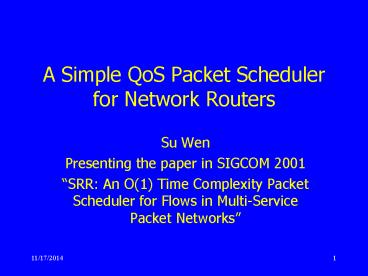A Simple QoS Packet Scheduler for Network Routers - PowerPoint PPT Presentation
Title:
A Simple QoS Packet Scheduler for Network Routers
Description:
10/2/09. 1. A Simple QoS Packet Scheduler for Network Routers. Su Wen. Presenting the paper in SIGCOM 2001 ' ... Provide service guarantees to individual flows ... – PowerPoint PPT presentation
Number of Views:50
Avg rating:3.0/5.0
Title: A Simple QoS Packet Scheduler for Network Routers
1
A Simple QoS Packet Scheduler for Network Routers
- Su Wen
- Presenting the paper in SIGCOM 2001
- SRR An O(1) Time Complexity Packet Scheduler
for Flows in Multi-Service Packet Networks
2
Quality of Service
- Current Internet Service
- Best effort
- Packet scheduling FIFO
- QoS
- Demanded by new network services
- multimedia, audio/video
- Meets requirement in bandwidth, delay, jitter
3
QoS Approaches
- Integrated Services
- Provide service guarantees to individual flows in
the network - GPS - Generalized Processor Sharing
- Weighted Fair Queuing
- Differentiated Services
- Provide some service guarantees to different
classes of traffic in the network - Example hierarchical link-sharing
- audio, video, telnet, ftp, mail
4
Bandwidth Sharing
- GPS - generalized processor sharing
- ideal model each flow gets its fair share of BW
- Si(t1, t2) / Sj(t1, t2) wi/wj
- ri/r wi/?jwj
flows
- wi - weight of flow i
- Si (t1, t2) - amount of traffic served for flow I
during time t1 to t2 - ri - service rate of flow i
- r - service rate of the server
5
Bandwidth Sharing Implementations
- Weighted Fair Sharing
- An approximation/implementation of GPS
- Each flow has separate queues
- Two approaches
- time-stamp based e.g. virtual clock
- round robin
6
Implementation Characteristics
- Time Stamp based
- Fairly good fairness and delay bound
- Time complexity O(logN) - O(N)
- Round Robin based DRR, CORR
- Time complexity O(1)
- Short term unfairness
- bursty output
7
SRR - Smoothed Round Robin
- Good short term and long term fairness
- emulate GPS
- work conserving
- forwards packets as long as there are active
flows - O(1) time complexity
- one lookup to decide what to send
- Better scalability
- Simplicity
8
Data Structures
- Weight Matrix (WM)
- number of rows N - number of flows
- number of columns k log2wmax 1
- of binary digits needed to represent the max
normalized weight - WM size depends on of flows and BW granularity
- WSS - Weight Spread Sequence
- WSS of order k (Sk) is a sequence of integers
from 1 to k - recursively defined
- S1 1
- Sk Sk-1, k, Sk-1
9
Weight Matrix
- Four flow f1 - f4, each with different BW
requirement - r1 64kbps, r2 128kbps, r3 320kbps, r4
192kbps - w1 1 -gt 0 0 1
- w2 2 -gt 0 1 0
- w3 5 -gt 1 0 1
- w4 3 -gt 0 1 1
- col1 col2 col3
- row1 0 0 1
- row2 0 1 0
- row3 1 0 1
- row4 0 1 1
10
Weight Spread Sequence
Rule S1 1 Sk Sk-1, k, Sk-1
- To find WSS of order 3 - S3
- S2, 3, S2
- S1, 2, S1, 3, S1, 2, S1
- 1, 2, 1, 3, 1, 2, 1
N - number of flows wi - normalized weight of
flow i k - log2wmax 1
11
Scheduling Algorithm
- Generate a Service Queue
- for each value i in the WSS
- if jth row of column i of WM has value 1
- add flow j to the queue
- Serve the flow indicated in the service queue in
a round robin fashion
f1 0 0 1 f2 0 1 0 f3 1 0 1 f4 0 1 1
S3
1, 2, 1, 3, 1, 2, 1
Flow Service Queue
f2, f4,
f3,
f2, f4,
f1, f3, f4,
f3
f3
f3,
12
Fairness
- Long Term
- Si(0, t) / Sj(0, t) wi/wj
- Si(0, t)/wi - Sj(0, t)/wj 0
- Short Term
- Si(0, t)/wi - Sj(0, t)/wj lt (k2)Lmax/2min(wi,wj)
Si(t1, t2) - amount of traffic served for flow i
during time t1 to t2 wi - normalized weight of
flow i k - log2wmax 1, the order of WSS
13
Delay
- Df - maximum delay for flow f
- Df lt 2Lmax/wf 2(N-1)Lmax/ ?i wi
- Inverse proportional to the weight of the flow
- Proportional to total number of flows
- Not strictly rate proportional, but better than
DRR - simulation result shows so
14
Scalability
- Space requirement
- N x k
- At 1kbps granularity, k16 can accommodate rates
up to 64Mbps - At 1Mbps granularity, k16 can accommodate rates
up to 64Gbps - Time complexity
- O(1) to choose packets for transmission
- O(k) to add or delete a flow
15
SRR Problems
- add_flow() and delete_flow() operations
- SRR scheduler is called during busy period
- packets are back-logged
- add_flow() is called when new flow arrives
- delete_flow() is called when queue of the flow is
empty - If a flow is not back logged, add_flow() and may
be called for every packet - quite expensive O(k)
- Solution
- delay the deletion of a flow
- not strictly O(1) any more
16
Conclusion
- SRR is simple
- even I can understand!
- Scalable
- time and space
- Good performance
- fairness
- delay
17
Questions?
- How did he come up with the algorithm?































